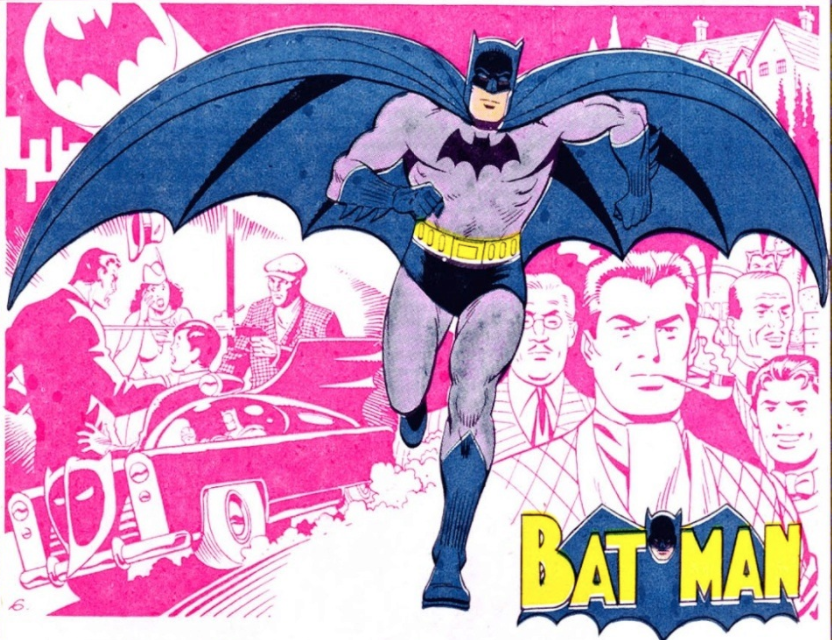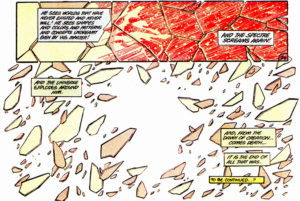—

Who’s Who: The Definitive Directory of the DC Universe #2 (1985)—art by Dave Gibbons
Welcome to the Golden Age Batman chronology. Special thanks to the wonderful resources provided by Aaron Severson, The Unofficial DCU Guide, The DC Comics Database, Michael Norwitz, Mike Voiles’ Amazing World of Comics, Chris Jarocha-Ernst, Comic Vine, James Lantz, ReadComicOnline, Sean Green, James Mahoney IV, Angus Livingstone, and any others I may have forgotten. This section of the Batman Chronology Project details the history of the Batman of the pre-original Crisis EARTH-2. This history comprises Batman and Batman-related DC publications ranging primarily from 1939 through 1960, with some added but minimal material published as late as 1986. As you will see (or may have already seen) in my other era chronologies, there is really no correct timeline when constructing a chronology that exists within the DC multiverse (which is a part of the greater omniverse aka multi-multiverse). I merely can suggest what I perceive to be the best and most accurate reading order based upon facts gleaned from within the pages of the comic books themselves. With that in mind, we can begin to tackle the Golden Age.
Golden Age Batman refers to the original Batman that debuted in Detective Comics #27 in 1939. In the late 1930s and early 1940s, Batman, Superman, and the JSA all occupied the same shared universe, but the connections were fairly tenuous. By the mid 1940s, DC took a page out of a competitor’s playbook. As The Absorbascon blog comments, Fawcett Publications had begun applying a film-style serial format into their comic books, notably starting with Captain Marvel Adventures #22 (1943). Throughout the mid 1940s and into the next decade-and-a-half, a serialized continuity-style storytelling would slowly emerge across the DC line. By 1964, DC publishers had already rebooted much of the entire DC Universe (starting with Showcase #4 in 1956), but they had yet to reboot Batman and Robin.[1] Thus, in the early 1960s, DC publishers decided it was finally time to let Batman and Robin join the rest of the DCU in the more sophisticated Silver Age. However, instead of simply erasing the long history of the Golden Age Batman, DC publishers executed a curious and innovative maneuver. The new rebooted adventures of Batman and Robin in the Silver Age, complete with a fresher and younger Dynamic Duo starting anew, were written as taking place on DC’s primary Earth, Earth-1. Golden Age Batman and Robin then became the Batman and Robin of a completely alternate Earth, Earth-2. The continuities of Earths 1 and 2 continued forward from that point, but separately—although Earth-1 characters did cross paths with their Earth-2 counterparts in a few interdimensional multiversial tales in the 60s, 70s, and 80s. A unique part of Earth-2 was that it seemed to progress in relative real-time. In May of 1939, when ‘tec #27 was released, Bruce Wayne is just finishing his training and has just graduated from college. Evidence in the comics seems to indicate that Bruce finishes school at 23-years-old shortly before turning 24-years-old on April 7, 1939 (Golden Age Bruce’s birthday in the comics), meaning he is 64-years-old by 1979. This seems to jibe pretty well with events in Earth-2’s history. Batman does age and even retires and has a daughter that grows into adulthood. Likewise, Robin grows into adulthood as well (although there are a long stretch of stories in the 50s and 60s where Robin seems to be aging way too slowly for comfort—we have to “age him” in our minds a bit in those decades). I mention 1979 specifically since that is the year when Earth-2 Batman is killed.

Crisis on Infinite Earths #10 by Marv Wolfman, Geroge Pérez, Jerry Ordway, & Anthony Tollin (1986)
Both Earth-1 and Earth-2 are “erased” in 1986 (in-story year 1985) with the mega-crossover event Crisis on Infinite Earths. The 1985-1986 Crisis functioned as DC’s second major reboot—the first being the Silver Age reboot that slowly occurred from the mid 1950s through the early 1960s. Crisis on Infinite Earths destroyed the majority of the multiverse and created one single new Earth that would go through many retcon events over the years, many bearing a “Crisis” name tag. Eventually, the new post-original-Crisis Earth (the DCU’s primary Earth of the Modern Age) would retain the name of Earth-0. But the story of the Modern Age is a story for another section of this site.[2] Since the Golden Age (the epoch featuring the pre-original-Crisis Earth-2) operates mostly in real-time, I’ve started the chronology in 1939.
_______________________________
_______________________________________________________________________________________
_______________________________
> > > ENTER THE GOLDEN AGE > > >
- [1]COLLIN COLSHER: I originally (and inaccurately) said that the reason for the delay of the Batman reboot into the Silver Age was due to the success of the campy 60s TV show starring Adam West and Burt Ward. Of course, this is incorrect since Batman wasn’t on the air until 1966. Additionally, the success of the TV show didn’t seem to have a positive effect on comic sales. In fact, according to Reed Tucker’s Slugfest (and various other sources), sales of Batman and Detective Comics were very low in the late 50s and early 60s. Despite tanking profit margins and bottomed-out market share, one of the reasons that Batman took so much longer to join the rest of the Silver Age was simply due to the conservative nature of the old guard creators at DC, who didn’t want to rock the boat, especially with their baby Batman.
PAPA SPANK!: While the campy Batman TV show did not air until 1966, it was in 1964 when Julius Schwartz retooled Batman and introduced his yellow oval look. During the 1960s, Batman actually became less campy and more realistic for a short time. Sillier characters like Batwoman, Batgirl, and Bat-Mite were dropped without explanation, which actually makes sense for the Batman Chronology Project! That said, one shouldn’t be afraid to move stories over to the Silver Age if they don’t mesh well with the Golden Age. And it’s true that comic sales numbers for Batman were definitely down in the late 1950s and early 1960s. In fact, the primary reason for Schwartz’ retool was due to the declining sales, which had gotten so bad (even with the success of the TV show) that DC higher-ups had no choice but to change or die. The narrative transfer from Earth-2 to Earth-1, however, was more-or-less an accident on DC’s part. While most Silver Age heroes had emerged many years prior, the famous “Flash of Two Worlds” that made the Silver Age a distinct alternate world had only appeared three years earlier. Continuity at this time wasn’t really paid very close attention to (at least not like today). It was only later retroactively decided that only Silver Age Batman had the yellow circle. It also seems to be agreed upon that anything before 1955 was definitely Golden Age Batman. This leaves the period between the mid 1950s and the early 1960s ambiguous. I like the idea of having the Golden Age end in the early-to-mid 1960s, as it ties in nicely with the Infinite Crisis era adding more Golden Age continuity into the Modern Age (thanks to Grant Morrison and Geoff Johns).↩
- [2]COLLIN COLSHER: It is also worth mulling-over an important fact that is fundamental to understanding all of these chronological listings: During DC’s huge company-wide reboots, it’s not just universes that are being erased, the entire timelines associated with each universe are being erased. For example, with Crisis on Infinite Earths it’s not as if Earth-1 and Earth-2’s timelines simply end with a cataclysm in 1985. If that were the case, then any reference to future tales or stories that occur after 1985 would be null and void. Because the DC multiverse operates under the tenets of determinism, all of its timelines are already entirely complete. 1985 is simply the focal point of an event that sucks dry and evaporates the entire Golden Age timeline from the before the Big Bang to the End of Days. And likewise, it wipes the entire Silver Age timeline from its pre-Big Bang to its End of Days. To better understand this concept we must also adopt a general scientific view of time as another dimension of space—as a where instead of a when. In the case of the original Crisis, 1985 isn’t just a calendar year for our intents and purposes; it is also the point in time (or space-time) where the universe-collapsing anomaly occurs. Furthermore, it is necessary to understand that the event is exactly that, an anomaly (albeit one deliberately started by a villainous force) that ceased to exist on any timeline until its inception. The same system can be applied to Flashpoint in 2011. The Modern Age timeline doesn’t simply end dead in its tracks in 2011. Remember, the entire Modern Age timeline is already complete (from the Dawn of the Gods to the Big Bang to the End of Days). Flashpoint is merely a space-time anomaly that occurs at the physical point 2011. This anomaly erases the entire Modern Age timeline, not just the universe. Furthermore, we should come to regard this type of erasure less like destruction and more like a conclusion or archiving of the timeline/universe in question.↩



“A question arises. Why did Batman take so much longer to join the rest of the Silver Age reboot? Were sales of Batman and Detective Comics really that much higher than other DC books in the late 50s and early 60s?”
While I don’t know how well Batman titles were selling in relation to other DC books at the time, what little internet research I’ve done suggests the reason for the retool was actually due to declining sales. I also think the transfer from Earth 2 to Earth 1 was a complete accident on their part. While most Silver Age heroes had emerged many year prior, the famous “Flash of Two Worlds” that made the Silver age a distinct alternate world had only appeared 3 years earlier. Continuity at this time wasn’t really paid very close attention to. I think it was only later that it was retroactively decided that only Silver age Batman had the yellow circle. It also seems to be agreed upon that anything before 1955 was definitely Golden Age Batman. This leaves the period between 1955 and 1964 to ambiguous. As I said earlier, I like your idea of having the Golden Age end at 1964, it ties in nicely with infinite crisis adding in more Golden Age continuity into the modern age (Thanks to Grant Morrison). I apologize for the long wall of text and if I’ve said anything you already know. Keep up the good work, this is by far the most detailed Batman chronology I have ever seen!
Thanks! And absolutely no need for apologies. Everything you’ve said is very enlightening and informative. I asked the question because I really didn’t know the answer. This is a great help moving forward!
So… has “Generations: Future State” and the story in Detective Comics #1027 made it so that this Batman is the one of the “Linearverse”? Would explain Dick Grayson’s super-slow aging.
I can’t stress this enough— Jurgens’ Generations has absolutely nothing to do with the original Golden Age timeline. It’s a wholly alternate timeline.
Now, there are a handful of people on the web saying that the concept of Linearverse matches up with the post-Death Metal idea of “everything matters” and “unknotted timeline,” therefore making this the potential first story of the new DC omniverse’s primary line. I think that’s ludicrous. And, as stated, Jurgens goes well out of his way on multiple occasions to tell us that the Linearverse is an alternate Elseworlds-style thing. Jurgens has also stated emphatically in interviews that the Linvearverse is NOT main continuity.